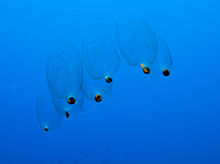- Doliolida
-
Doliolida 
Scientific classification 
Kingdom: Animalia Phylum: Chordata Subphylum: Tunicata Class: Thaliacea Order: Doliolida Doliolida are small marine animals of the Tunicata phylum, related to salps and pyrosomas.[1] The Doliolid body is small, typically 1–2 cm long, and barrel-shaped; it features two wide siphons, one at the front and the other at the back end, and eight or nine circular muscle strands reminiscent of barrel bands. Like all tunicates, they are filter feeders. They are free-floating; the same forced flow of water through their body with which they gather plankton is used for propulsion - not unlike a tiny ramjet engine. Doliolids are capable of quick movement. They have a complicated life cycle consisting of sexual and asexual generations. They are nearly exclusively tropical animals, although a few species can be found as far to the north as North California.
Doliolid life cycle
Doliolids alternate through sexual and asexual generations. The sexual generation consists of individuals featuring eight muscle bands, each having male or female gonads. These individuals are called gonozooids. Fertilized eggs produce slightly different individuals, featuring nine muscle bands, no gonads, and two stalks growing from each individual's body: the shorter one at the ventral side, and the longer one growing from the dorsal edge of the posterior siphon. Each of these asexual individuals, nicknamed "nurses", produces an astonishing number of asexually grown progeny, both sexual and asexual zooids in three sequential "generations".[2]
The "nurse" produces buds (which grow into new zooids) in its ventral stalk, but the buds grow and mature on its dorsal stalk. Each bud is an aggregate of a few dozen cells, and the way it gets to its final place is the first peculiarity of doliolid reproduction. Buds are immobile, but are actively carried by special mobile cells, called phorocytes - "carrier cells", shaped like amoebas. Each bud is transported by several phorocytes, which follow a clearly defined path across the "nurse's" body: up the ventral stalk, in a spiral along the left side of the "barrel", and finally onto and along the dorsal stalk.
The first buds are planted in pairs on both sides of the dorsal stalk. They grow into zooids not unlike the "nurse", attached to its dorsal stalk with their own dorsal stalks. They are not barrel-shaped, though; their intake siphons are so wide that the individual is more like a spoon than a barrel. These zooids feed the whole colony, which shares common blood circulation (two blood-filled sinuses extend from the "nurse" into complete length of the dorsal stalk). As this first generation grows, the "nurse's" feeding role is gradually diminished, and at the point where the colony's nutrition is supplied by the stalk zooids the "nurse" loses most of its organs, becoming a purely generative and propulsive agent, dragging its huge "tail" of grape-like stalk through the water.
As the dorsal stalk grows and more zooids are planted on its sides, the phorocytes begin to plant a second batch of buds in two more rows between the first two, on the dorsal side of the stalk. These grow into asexual zooids that are smaller, barrel-shaped like the "nurse", and attached to the "nurse's" stalk with their ventral stalks. They do not have a dorsal stalk themselves. This "generation" is called phorozooids, "carrier zooids" because of their later function.
Finally, when the two phorozooid rows on the "nurse's" stalk are filled up and the first phorozooids grow big enough, the phorocytes begin to plant subsequent buds on the stalks of phorozooids, which are still attached to the main colony at this point. It is only this third batch of buds that eventually grows into gonozooids - the sexual generation.
As phorozooids mature, their stalks detach from the "nurse's" stalk, and they swim away on their own, carrying budding gonozooids on their own stalks. The "nurse" and its battery of feeding zooids goes on until all carriers leave, and then the whole colony dies off. The carriers go on as long as it is required for the gonozooids on their stalks to grow and detach, and then they die off too.
Gonozooids detached from the phorozooid swim free, mate, and produce fertilized eggs - from which springs the next generation of asexual zooid "factories", and the cycle repeats. The total number of zooids produced by a single "nurse" colony can reach tens of thousands - explosive growth unprecedented in the animal kingdom.
References
- ^ Doliolida World Register of Marine Species. Retrieved 2011-11-17.
- ^ Dolioletta gegenbauri Uljamin, 1884 : Doliolid JelliesZone. Retrieved 2011-11-17.
Categories:- Tunicates
Wikimedia Foundation. 2010.
